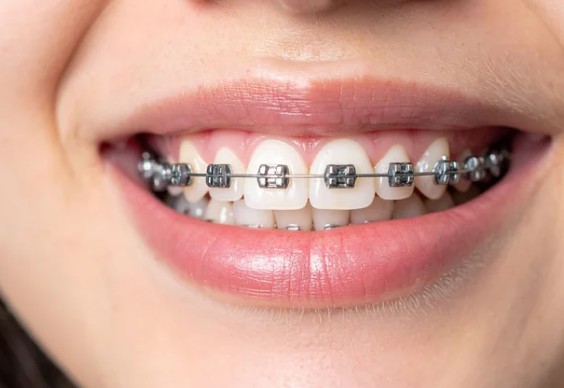Selecting the right braces is a key decision for your orthodontic treatment. Whether you prefer a subtle or traditional look, understanding the differences between clear and metal braces is crucial for making an informed choice. Patients often compare these options based on appearance, comfort, cost, and treatment efficiency. While both effectively straighten teeth, each offers distinct benefits that suit different lifestyles and goals.
Appearance: Subtle vs. Classic
Clear Braces: A More Discreet Option

Clear braces are chosen for their aesthetic. Made from ceramic, they blend with your natural tooth color, making them far less noticeable than metal braces. This subtle design is popular with teens and adults seeking a more discreet orthodontic option. Those wanting a nearly invisible treatment appreciate how seamlessly ceramic brackets blend, allowing them to smile with confidence throughout the process.
Metal Braces: A Bold and Reliable Classic
Metal braces have been the go-to orthodontic treatment for decades and remain a trusted option. Though more noticeable, modern metal braces are smaller and more comfortable than ever. Many patients enjoy personalizing them with colored bands, making the process more fun and expressive. While visually prominent, metal braces are known for their durability, making them a reliable choice for any alignment issue.
Strength and Durability
Clear Braces: Strong but Slightly More Delicate
Ceramic brackets are strong, but less durable than metal. While effective, they can chip or crack if not properly maintained. Patients must avoid hard foods or habits like chewing on pens or ice. Clear braces are still sturdy for daily use, but they do require more care to prevent breakage.
Metal Braces: Built to Handle More Pressure
Metal braces are highly durable and can handle greater orthodontic pressure, making them ideal for patients with complex alignment issues or significant adjustment needs. Their strength reduces the risk of bracket breakage and minimizes the need for repairs during treatment. For advanced orthodontic cases, metal braces provide a reliable and resilient solution.
Comfort and Daily Experience
Clear Braces: Smooth and Comfortable
Clear braces have smoother edges, reducing irritation inside the mouth. Most patients find them comfortable after a brief adjustment period. Their discreet design often boosts confidence in professional, academic, and social settings. However, ceramic brackets are slightly larger than metal ones, so some users may experience mild rubbing until they fully adapt.
Metal Braces: Smaller but Noticeable

Metal braces are usually smaller than ceramic ones, making them a bit easier to clean. While there might be initial discomfort, most patients quickly adjust. Their discreet design still offers comfort, especially with modern orthodontic methods. Metal brackets can cause slight friction, but orthodontic wax helps ease irritation early on.
Treatment Speed and Effectiveness
Clear Braces: Effective but May Require Extra Care
Clear braces straighten teeth as effectively as metal braces for many cases. However, because ceramic brackets can’t tolerate as much force, treatment may progress more slowly for certain alignment needs, depending on the individual case’s complexity. Most patients using clear braces in Taylorsville achieve excellent results, though their timeline may differ slightly from metal options.
Metal Braces: Typically Faster for Complex Cases
Metal braces are often faster for correcting significant crowding, spacing, or bite issues. Because they can handle stronger adjustments, orthodontists can move teeth more efficiently. Patients looking for the quickest path to a straighter smile often choose metal options. While both choices are effective, your individual treatment plan will determine which one best meets your needs.
Maintenance and Stain Resistance
Clear Braces: Beautiful but Prone to Staining
Ceramic brackets themselves don’t stain, but the elastic ties around them can. Foods like curry, sauces, coffee, and tea might discolor the ties over time. Good oral hygiene and regular appointments help keep clear braces looking clean.
Metal Braces: Less Concern for Discoloration
Metal braces won’t stain, no matter what you eat or drink. This simplifies maintenance and removes any worry about discoloration during your treatment. They are easy to clean and will keep their color throughout the orthodontic process.
Cost Considerations
Clear Braces: Slightly Higher Investment
Clear braces tend to cost more due to the ceramic material and the more detailed installation process. Many patients feel the added cost is worth it for the cosmetic benefits and confidence-boosting appearance.
Metal Braces: More Budget-Friendly
Metal braces are generally more affordable, making them a popular choice for families and individuals who want effective treatment at a lower cost.
Also Read: How to Prepare Your Toddler for Their First Dental Checkup
Conclusion
Both clear and metal braces are effective options for achieving a straighter, healthier smile. The right choice depends on your lifestyle, aesthetic preferences, and treatment goals. Whether you prefer the subtle appearance of ceramic braces or the proven durability of metal ones, understanding these key differences will help you confidently select the best treatment for your needs.








